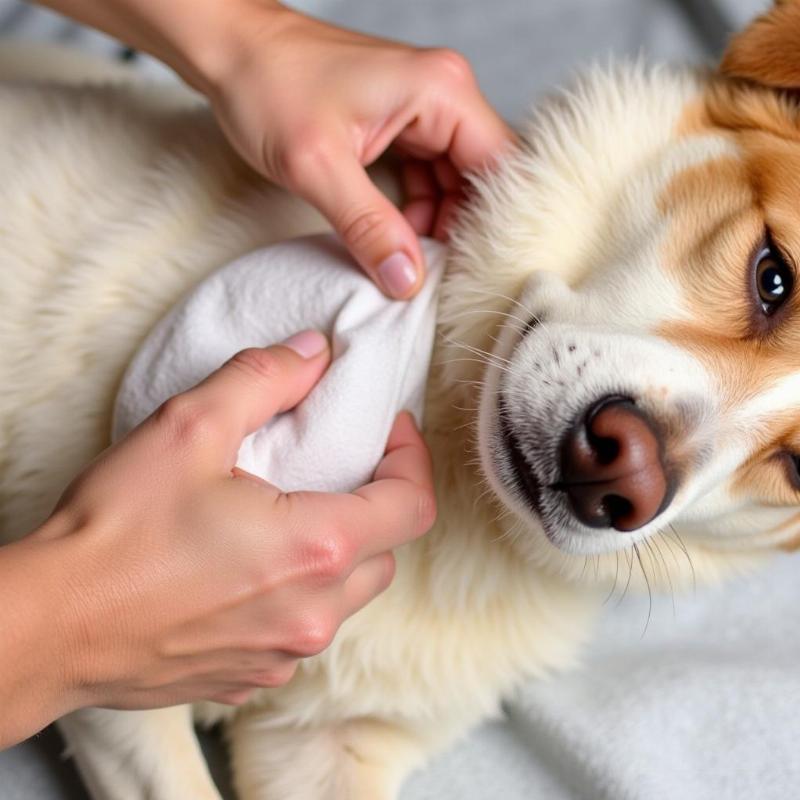The arrival of puppies is a joyous occasion, but the journey doesn’t end with weaning. Sometimes, a mother dog’s milk needs to be dried up prematurely, whether due to a stillbirth, the puppies being weaned early, or health concerns. While “tablets to dry up dog’s milk” is a common search term, it’s crucial to understand the risks and alternatives before considering medication. This comprehensive guide will delve into safe and effective methods to suppress lactation in dogs, addressing your concerns and offering vet-approved solutions.
Understanding Lactation Suppression in Dogs
Drying up a dog’s milk supply, also known as lactation suppression, requires a gradual and careful approach. Abruptly stopping milk production can lead to mastitis (inflammation of the mammary glands), painful engorgement, and behavioral changes due to hormonal fluctuations. Therefore, understanding the underlying reasons for wanting to suppress lactation is the first step.
When Is Lactation Suppression Necessary?
Several situations may warrant drying up a dog’s milk:
- Pseudopregnancy (false pregnancy): This hormonal imbalance mimics pregnancy symptoms, including milk production, even without actual conception.
- Weaning puppies early: If puppies need to be weaned early due to health reasons, the mother’s milk supply will need to be managed.
- Loss of puppies: A stillbirth or the death of puppies necessitates suppressing lactation.
- Mastitis: In some cases, drying up the milk supply can help resolve mastitis.
 Drying Up Dog's Milk Naturally
Drying Up Dog's Milk Naturally
Natural Methods to Dry Up a Dog’s Milk
Before considering medication, natural methods are often the safest and most preferred approach for drying up a dog’s milk:
- Gradual weaning: If puppies are still nursing, gradually reduce their feeding frequency and duration over several days. This allows the mother’s body to adjust and slow down milk production.
- Restrict food and water intake (slightly): Reducing the mother dog’s calorie intake can help decrease milk production. Consult your vet for specific guidelines as over-restriction can be harmful.
- Cold compresses: Applying cold compresses to the mammary glands can help reduce swelling and discomfort associated with engorgement and may also slow down milk production.
- Supportive bra or wrap: A snug-fitting, supportive bra or wrap can provide comfort and help prevent further milk production by minimizing stimulation.
- Herbal remedies: Some herbs, like parsley and sage, are believed to have milk-drying properties. However, always consult a holistic veterinarian before using any herbal remedies.
Medications for Lactation Suppression in Dogs
While natural methods are usually preferred, your veterinarian might prescribe medication in certain situations. It is crucial to never administer any medication without your vet’s explicit instructions.
Cabergoline
Cabergoline is a dopamine agonist that can be used to suppress lactation in dogs. It works by inhibiting prolactin, the hormone responsible for milk production. Your veterinarian will determine the appropriate dosage and duration based on your dog’s specific needs.
Potential Side Effects of Medication
Like any medication, cabergoline can have potential side effects, including vomiting, loss of appetite, and lethargy. If you observe any adverse reactions, contact your veterinarian immediately.
What NOT to Do
- Do not bind or tightly wrap the mammary glands. This can lead to mastitis and other complications.
- Do not abruptly stop feeding puppies. Gradual weaning is crucial for both the mother and the puppies.
- Do not administer any medication without veterinary guidance.
Conclusion
Drying up a dog’s milk requires a careful and informed approach. Prioritize natural methods, and always consult your veterinarian before considering medication or if you encounter any concerns during the process. By understanding the underlying causes and following vet-approved strategies, you can ensure a safe and comfortable experience for your furry friend. Remember, tablets to dry up dog’s milk should only be used under veterinary supervision.
FAQ
- How long does it take to dry up a dog’s milk naturally? This can vary, but typically takes a few days to a couple of weeks, depending on the dog and the methods used.
- What are the signs of mastitis in dogs? Signs include redness, swelling, pain, and heat in the mammary glands. You might also notice pus or blood in the milk.
- Can I use human medication to dry up my dog’s milk? Absolutely not. Human medications can be toxic to dogs and should never be administered without veterinary guidance.
- Is it painful for a dog to dry up her milk? Some discomfort is normal, especially with engorgement. Cold compresses and supportive wraps can help alleviate discomfort.
- When should I contact my veterinarian? Contact your veterinarian if you notice any signs of mastitis, if your dog seems excessively uncomfortable, or if you have any concerns about the process.
- Are there any long-term effects of lactation suppression? Generally, there are no long-term effects if the process is managed correctly under veterinary supervision.
- Can a dog get pregnant again while she is still lactating? Yes, it’s possible for a dog to go into heat and become pregnant again while lactating.
Beautdogs.us is your trusted source for all things dog-related in the US. We offer expert advice, breed information, and product recommendations to help you navigate the world of dog ownership. Whether you’re a seasoned pet parent or just starting your journey, Beautdogs.us has you covered. Connect with our team of experts today for personalized guidance. Email us at [email protected] or call us at +1 501-555-7529.